 You’ve bought and/or cleaned your feeders.
You’ve bought and/or cleaned your feeders.
You’ve taken the time to set up your feeding station to maximize the numbers of birds and bird species that might use it.
You’ve purchased high-quality, non-GMO bird feed and have stocked your station.
You’ve waited with excitement to see who comes to use your new arrangement.
…Common Grackles and European Starlings…
Sound familiar?
In their defence, both grackles and starlings are beautiful and intelligent birds that are only doing what all birds (and mammals) do… seeking and using readily available food sources. If you put out food they like in a set-up they can use, they will.
The problem for many is that both species are also aggressive at feeders (as are Blue Jays) and essentially “bully” other species away from the feeder. European Starlings are non-native (introduced from England into New York’s Central Park in the late-1800s) and invasive, often taking over native cavity-nesting species’ nests, either by excluding the adults or by destroying their eggs and taking over the nest. Although native to the area, Common Grackles can be aggressive nest predators that eat the eggs and young nestlings of other species.
So, what to do?
One option is to accept and get to know these species. As mentioned, they are beautiful and intelligent, their behaviour can be fascinating, and starlings are remarkable mimics able to copy the songs of a range of species.
Another option is to change your setup to make it less attractive or available to grackles and starlings. It may be ineffective, but a good start is to seal up any gaps or openings in your home, garage, or outbuildings that starlings might use for nesting.
In terms of feeders and feed, you can…
…make the food you put out harder for them to get:
- smaller feeders may not allow larger-bodied species access to food
- caged feeders allow smaller birds access while excluding grackles, starlings, and jays
- Squirrel Buster feeders can be set to exclude the heavier grackles, and you can remove the perching ring to make them harder for starlings to use while still allowing smaller birds to
- the holes in finch feeders are too small for grackles to access the finch seed
- both species have a difficult time using upside-down suet feeders
and/or…
…make the food you put out less attractive to them:
- remove their preferred foods – sunflower seeds and peanuts – from your seed mix when they first arrive
- offer safflower or our squirrel-free blend, which they don’t like.
